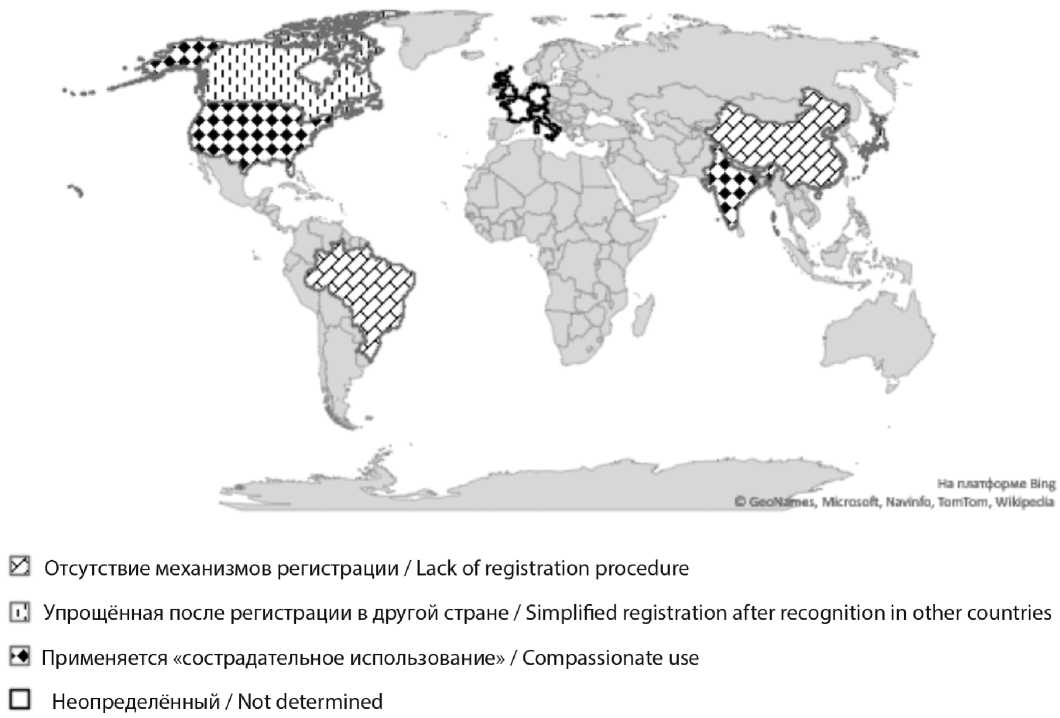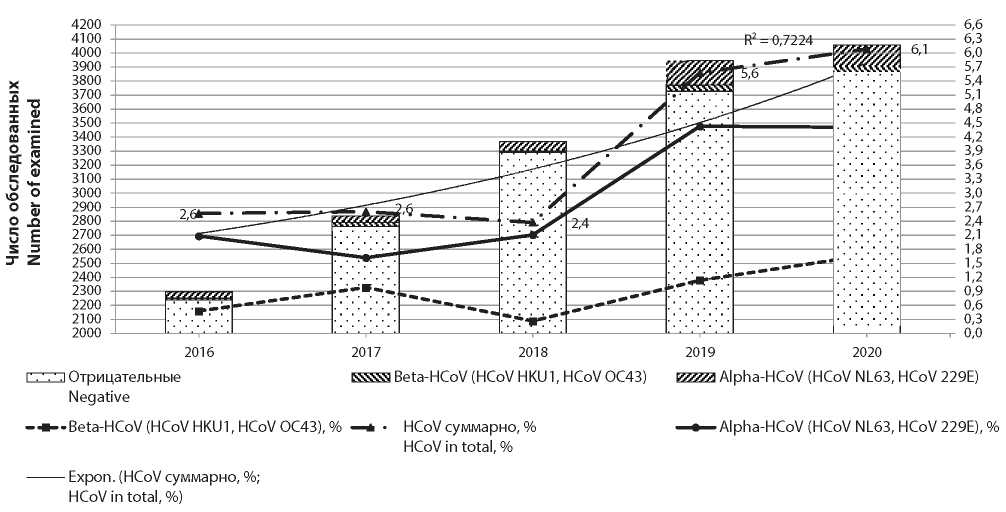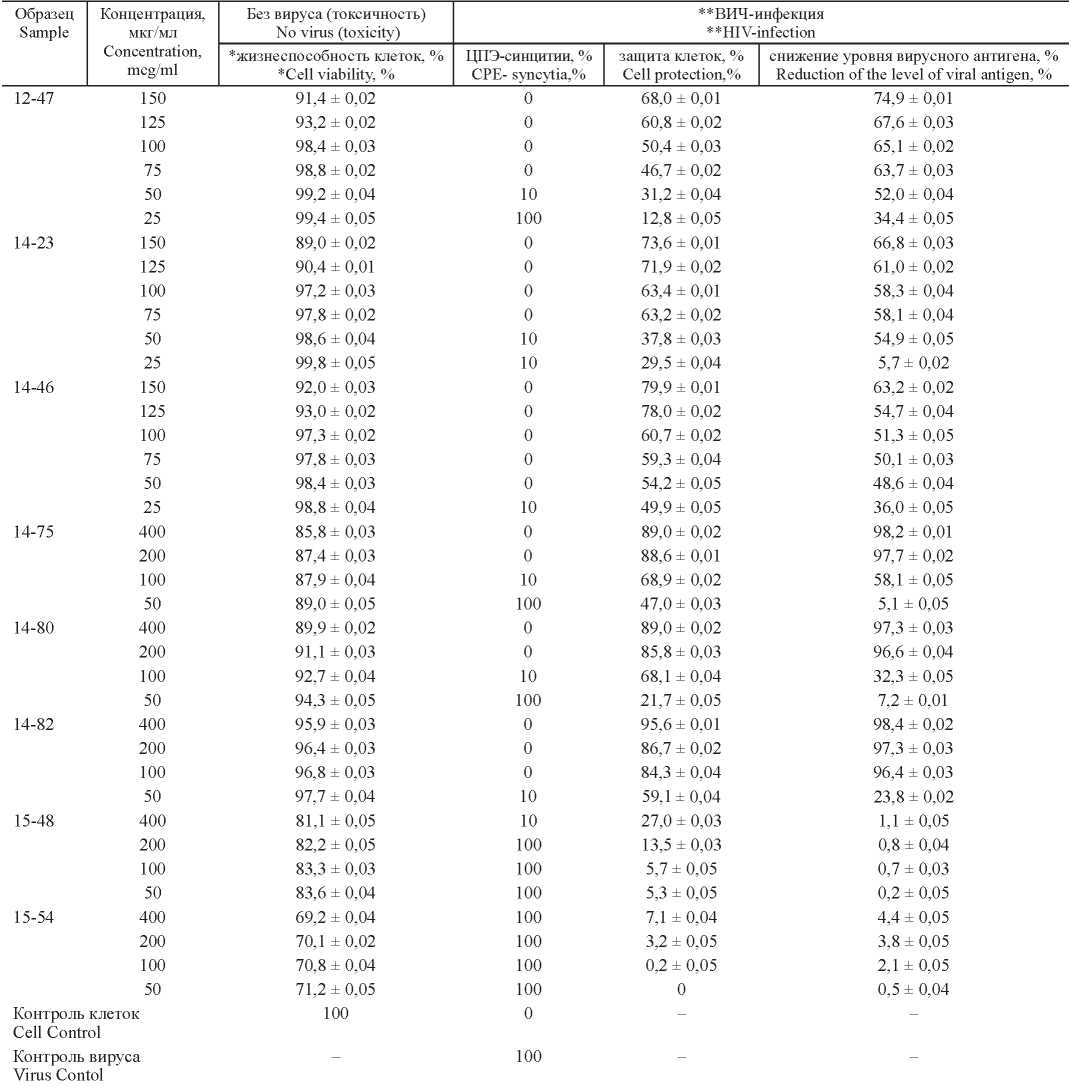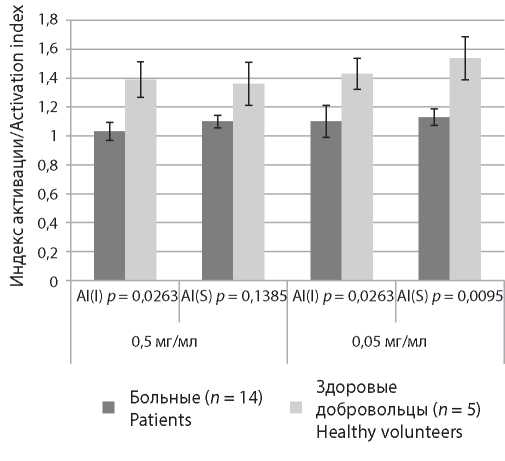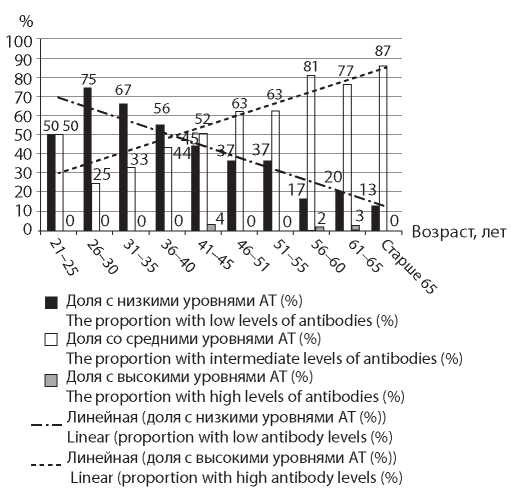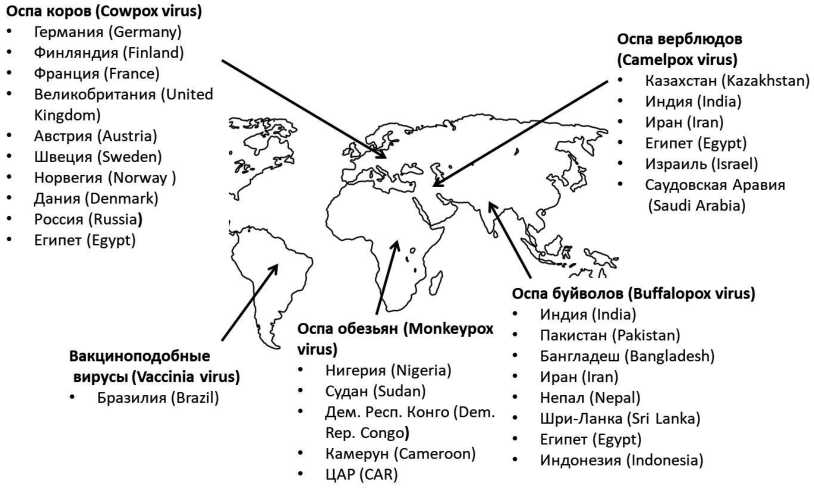Том 65, № 5 (2020)
- Год: 2020
- Выпуск опубликован: 16.11.2020
- Статей: 6
- URL: https://virusjour.crie.ru/jour/issue/view/46
Весь выпуск
ОБЗОРЫ
Обзор законодательства в области обращения персонализированных препаратов бактериофагов
Аннотация
 259-266
259-266


ОРИГИНАЛЬНЫЕ ИССЛЕДОВАНИЯ
Анализ циркуляции коронавирусов человека
Аннотация
Введение. Появление в конце 2019 г. нового коронавируса SARS-CoV-2, ставшего причиной пандемии, породило массу вопросов относительно эпидемиологии нового заболевания COVID-19 и известных ранее инфекций, вызываемых коронавирусами, которым по причине более лёгкого течения заболеваний уделяли мало внимания.
Цель данной работы – многолетнее ретроспективное исследование распространённости и особенностей циркуляции эпидемических коронавирусов человека в Москве при проведении рутинного скрининга.
Материал и методы. Методом полимеразной цепной реакции с детекцией в режиме реального времени исследовали на РНК эпидемических коронавирусов человека (HCoVs) мазки из носо- и ротоглотки 16 511 больных острой респираторной инфекцией (ОРИ) в возрасте от 1 мес до 95 лет (58,3% составили дети), собранные с января 2016 г. по март 2020 г., и мазки 505 условно-здоровых детей, собранные в 2008, 2010 и 2011 гг.
Результаты. HCoVs обнаруживали у 2,6–6,1% обследованных больных в год, статистически значимо чаще у взрослых по сравнению с детьми, без различий по полу. На пике заболеваемости в декабре 2019 г. HCoVs обнаружены у 13,7% обследованных, что в 2 раза выше среднемноголетнего уровня данного месяца. У больных ОРИ детей до 6 лет HCoVs выявляли статистически значимо чаще, чем у здоровых (3,7 vs 0,7%, p = 0,008).
Заключение. HCoVs циркулируют ежегодно, демонстрируя в Московском регионе зимне- весеннюю сезонность с пиком в декабре. За годы наблюдения эпидемическая активность HCoVs росла до максимальных значений в декабре 2019 г. – феврале 2020 г., снизившись в марте до среднемноголетнего уровня. На фоне растущего количества случаев завоза SARS-CoV-2 в Москву в марте 2020 г. частота выявления HCoVs резко понизилась, что, по-видимому, отражает наличие конкуренции между разными коронавирусами и подтверждает специфичность выявления HCoVs использованным в данной работе диагностическим набором.
 267-276
267-276


Противовирусная активность экстрактов базидиомицетов и гуминовых соединений в отношении вируса иммунодефицита человека (Retroviridae: Orthoretrovirinae: Lentivirus: Human immunodeficiency virus 1) и вируса простого герпеса (Herpesviridae: Simplexvirus: Human alphaherpesvirus 1)
Аннотация
Введение. Актуальнейшей проблемой современной медицины является борьба с заболеванием, вызываемым вирусом иммунодефицита человека (ВИЧ), – ВИЧ-инфекцией. Применяемые химические соединения улучшили ситуацию для инфицированных, однако они токсичны, нарушают обмен веществ и не могут избавить организм от интегрированного вируса. Появление резистентных штаммов ВИЧ делает эти лечебные средства неэффективными. Часто смерть ВИЧ-инфицированных наступает в результате развития оппортунистических инфекций, вызванных вирусами семейства Herpesviridae. Поэтому актуален поиск новых лечебных и профилактических препаратов, менее токсичных, активных в отношении нескольких вирусов одновременно. Базидиомицеты, высшие грибы, являются источником лекарственных соединений, обладающих антимикробными и противовирусными свойствами. Гуминовые соединения (ГС) различной природы также обладают противовирусной активностью.
Цель исследования – получение и испытание нетоксичных препаратов из базидиомицета Inonotus obliquus и ГС из бурых углей в отношении вирусов, патогенных для человека: ВИЧ и вируса простого герпеса (ВПГ).
Материал и методы. На модели лимфобластоидных клеток MT-4, инфицированных штаммами ВИЧ, тип 1 (ВИЧ-1), и монослойной культуры клеток Vero, инфицированной ВПГ, тип 1 (ВПГ-1), изучена противовирусная активность экстрактов меланина, полученных из культивируемой культуры гриба чага Inonotus obliquus, и ГС – из бурого угля Канско-Ачинского месторождения с использованием вирусологических и статистических методов исследования.
Результаты и обсуждение. Установлено, что все исследованные соединения не обладали цитотоксическим действием на клетки при концентрации 100 мкг/мл. Показано, что экстракты базидиомицетов и ГС обладают противовирусной активностью в отношении ВИЧ-1 и ВПГ-1. ЭК50 (50% эффективная концентрация) в отношении ВИЧ-1 составила 3,7–5,0 мкг/мл, индекс селективности – 28–35. Противогерпетическая активность обнаружена при дозе 50–100 мкг/мл. Противовирусная эффективность меланиновых соединений установлена как при «профилактической» (за 2 ч до инфицирования клеток), так и при «лечебной» схеме введения препаратов как в отношении ВИЧ-1, так и ВПГ-1. Наличие противовирусной активности меланина и ГС в отношении РНК-содержащего вируса ВИЧ-1 и ДНК-содержащего вируса ВПГ-1 в нашем исследовании совпадает с результатами ряда авторов в отношении вирусов гриппа, герпеса, ВИЧ, гепатита В, Коксаки, осповакцины, что позволяет высказать предположение о том, что тип нуклеиновой кислоты вируса не играет принципиальной роли в антивирусном действия этих препаратов. Очевидно также, что ГС эффективны как в отношении вирусов с оболочкой, так и безоболочечных вирусов.
Заключение. В целом можно заключить, что для меланиновых и гуминовых соединений характерна низкая токсичность при наличии и вирулицидной, и противовирусной активности. Это позволяет рассматривать исследованные соединения как основу для создания безопасных лекарственных средств, эффективных в отношении возбудителей различных вирусных инфекций.
 276-283
276-283


Интерферон-регулирующая активность противовирусного лекарственного средства целагрип и его влияние на экспрессию генов врожденного иммунитета и образование активных форм кислорода у больных фолликулярной лимфомой
Аннотация
Введение. Лекарственные средства из группы индукторов интерферона (IFN) «включают» синтез интерферонов 1-го типа (IFN-I) и индуцируют экспрессию IFN-стимулированных генов (ISG), которые регулируют реакции врожденного иммунитета и защищают хозяина от инфекционных агентов и опухолевой патологии.
Цель исследования – определить роль лекарственного средства (ЛС) целагрип (ЦА) в активации генов врожденного иммунитета и влиянии на продукцию активных форм кислорода у больных фолликулярной лимфомой (ФЛ). Задачи: изучить интенсивность продукции активных форм кислорода (АФК) и уровень экспрессии генов IFN-α2, IFN-λ1, ISG15, BCL2, P53(ТР53) и USP18 в ответ на обработку ЦА клеток крови больных ФЛ.
Материал и методы. В исследовании участвовали первичные онкологические пациенты с диагнозом ФЛ и здоровые добровольцы, у которых выполнен кинетический анализ динамики продукции АФК клетками крови и определена экспрессия группы генов методом полимеразной цепной реакции в реальном времени в ответ на обработку ЦА.
Результаты и обсуждение. Выявлено статистически достоверное снижение продукции АФК клетками крови больных ФЛ и здоровых добровольцев в присутствии ЦА (P < 0,05). Кратность стимуляции генов ISG15, P53(ТР53) и USP18 в группе больных ФЛ значительно превышала таковую в группе здоровых добровольцев. При обработке ЦА клеток крови становится возможным разделить больных ФЛ на группы с положительным и отрицательным ответом в соответствии с уровнем экспрессии гена USP18.
Выводы. ЦА снижает продукцию АФК и одновременно стимулирует активность генов врожденного иммунитета ISG15, P53(ТР53) и USP18 в клетках крови больных ФЛ.
 284-293
284-293


Напряжённость иммунитета против кори у сотрудниц родильного блока в городе Москве
Аннотация
Введение. Корь остаётся актуальной проблемой российского здравоохранения, несмотря на проводимую вакцинопрофилактику, наблюдается рост заболеваемости. Особенно важна профилактика кори в группах риска, а также среди медицинских работников для предотвращения внутрибольничных вспышек инфекции. Продолжительность поствакцинального иммунитета в период элиминации кори изучена недостаточно, поэтому часто лица, переболевшие корью в детстве или имеющие 1–2 прививки против заболевания, с возрастом, в отсутствие естественной бустеризации, утрачивают защитные антитела.
Цели и задачи. Изучить напряжённость специфического иммунитета к кори у сотрудниц родильного отделения.
Материал и методы. В исследовании участвовала 271 сотрудница родильного блока в возрасте от 21 до 93 лет (262 образца сыворотки). Уровень специфических антител (АТ) класса G (IgG) к вирусу кори в сыворотках крови исследовали методом иммуноферментного анализа (ИФА) с использованием стандартного набора реагентов для иммуноферментного количественного определения IgG фирмы «ВЕКТОР-БЕСТ». Результат считался отрицательным, если концентрация IgG-АТ к вирусу кори в исследуемом образце была менее или равна 0,18 МЕ/мл, и положительным – более 0,18 МЕ/мл.
Результаты. Среди сотрудниц число серонегативных составило от 0% до 30,8% с максимумом в возрасте 31–35 лет. Наименьшую долю серонегативных и наибольшую долю серопозитивных женщин наблюдали среди представителей пожилого возраста – > 60 лет.
Обсуждение. Показана выраженная тенденция к росту доли лиц со средними уровнями АТ с возрастом и к спаду доли лиц с низкими уровнями АТ. Доля серонегативных женщин среди сотрудниц превышала рекомендуемый уровень, что делает возможной внутрибольничную вспышку при заносе инфекции.
Выводы. Авторы статьи рекомендуют включить серологическое исследование на напряжённость иммунного ответа против кори в стандарт обследования взрослых перед вакцинацией.
 294-300
294-300


РЕДАКЦИОННАЯ КОНЦЕПЦИЯ
Формирование популяционного генофонда потенциально угрожающих биобезопасности зоонозных вирусов
Аннотация
Коронавирусы начали формировать генофонд, взаимодействуя с земноводными (подсемейство Letovirinae), но в основном с рукокрылыми (Chiroptera) в третичном периоде (110–85 млн лет назад), образуя также переход на парнопалых (эоцен, 70–60 млн лет назад) и лишь 10–2 тыс. лет до н.э. приобретя способность к респираторной передаче (в первую очередь, вероятно, представителями рода Alphacoronavirus), обособились в сезонную инфекцию людей. Подобная ситуация возможна в ближайшем будущем с SARS-CoV-2. Эпидемические катаклизмы, более серьезные, чем COVID-19, связанные с зоонозными вирусами, вероятно, возникнут и в будущем. Необходим постоянный мониторинг популяционных генофондов зоонозных вирусов.
 243-258
243-258











